
Guests
- Phil Millerchief reporter for Declassified UK, an independent media outlet that focuses on national security.
The Biden administration is expected to send armor-piercing munitions containing depleted uranium to Ukraine as part of the latest military aid package, even though the weapons are radioactive and their use causes contamination that is hazardous to human health. It’s the latest escalation in the war between Ukraine and Russia that nonproliferation activists warn could possibly lead to a nuclear confrontation. The United Kingdom already provided Ukraine with depleted uranium munitions earlier this year, one of which sparked contamination fears when it was reportedly destroyed by Russian forces over the weekend, and the Biden administration followed that up by sending cluster bombs, which have been banned by an international treaty ratified by more than 110 nations. “On top of dealing with unexploded cluster munitions, they’re also going to have this huge hazard of depleted uranium to contend with, as well,” Phil Miller, chief reporter for the independent news outlet Declassified UK, says of the risk to civilians.
Transcript
AMY GOODMAN: This is Democracy Now!, democracynow.org, The War and Peace Report. I’m Amy Goodman, with Juan González.
We turn now to Ukraine, where U.S. Secretary of State Antony Blinken has arrived in Kyiv on an unannounced visit to Ukraine, expected to announce a new package worth more than $1 billion in U.S. aid for Ukraine. This comes as the Biden administration is reportedly planning to announce it will for the first time send depleted uranium munitions to Ukraine, even though the weapons are radioactive and their use causes contamination that’s hazardous to human health. Reuters reports the armor-piercing uranium munitions are part of a new military aid package for Ukraine set to be unveiled in the next week.
This follows a previous decision by the Biden administration to arm Ukraine with cluster munitions, which have been banned by an international treaty ratified by more than 110 countries. This week, a new report by the Cluster Munition Coalition found 916 deaths and injuries from cluster bombs in Ukraine last year.
Meanwhile, it was reported Monday one of the 14 so-called Challenger 2 tanks that Britain sent to Ukraine, with the capacity to fire depleted uranium shells, was destroyed in a battle with Russian forces in the village of Robotyne, which Ukraine says its troops recently captured in its counteroffensive.
For more, we go to London. We’re joined by Phil Miller, chief reporter for Declassified UK, an independent media outlet that focuses on national security. His story is headlined “Contamination Fears After Ukraine Loses British Tank.”
Welcome to Democracy Now! It’s great to have you with us, Phil. Can you start off by responding, though you’re in Britain, to the U.S., what looks like the Biden administration decision to send DU munitions to Ukraine? And tell us what you found in your exposé with the British tank that was just destroyed.
PHIL MILLER: Thank you for having me, Amy.
So, I think Biden’s decision to send tanks with depleted uranium to Ukraine has been made possible in large part because Britain led the way on this. If you remember, back in January, our prime minister here, Rishi Sunak, announced that Britain was going to send these 14 tanks. And that was at a time when it was controversial just to send tanks, and that helped cross the redline. And after that, we saw countries like Germany announcing that they would send much larger quantities of tanks to Ukraine. And this has really been Britain’s role throughout this war, has been to kind of up the ante and to lead the way on weapon supplies to Ukraine, despite the kind of escalatory fears about what effect that’s having on the battlefield. So, starting with anti-tank launches back right before the invasion to then tanks to, more recently, even cruise missiles, this seems to be the role that Britain has played in the conflict. And it makes it easier for other countries, like Germany or now the U.S., to send much larger quantities of weapon systems once considered controversial.
Now, the reason that depleted uranium is so controversial is because it’s essentially a byproduct of nuclear waste, and it is radioactive. The U.K. stockpile even contains some trace amounts of plutonium. And much of this was made in the '80s and ’90s, and the stuff that we've been sending out to Ukraine, some of it may even have expired. But it was used, most notably, in the Gulf wars in Iraq. And there has been long concern there about birth defects and cancers linked to the use of this ammunition in Iraq and also in the former Yugoslavia. And so, when I revealed back in March that Britain was actually sending this ammunition with its Challenger 2 tanks, there was international outcry. Farhan Haq, the U.N. secretary-general spokesman, came out and condemned the decision by the U.K. to supply these weapons. And Russian President Vladimir Putin, quite predictably, used it as a pretext to send tactical — so-called tactical nuclear weapons to Belarus, which brought Europe and the world one step closer to nuclear confrontation and the catastrophic consequences that would flow from that. So, even before these weapons have been fired in Ukraine, it already had adverse implications for international peace.
Now, the British Ministry of Defense says that there’s a low risk to human health from using these weapons. And it says it’s necessary because depleted uranium is an ultra-dense metal that’s able to punch through tank armor in a way that other munitions aren’t able to. So, it’s made as, essentially, a dart that’s fired through enemy tanks. But this justification is slightly undermined by the fact that the U.K. military also likes to point out that Russia is increasingly having to use very antiquated tanks, including T-62s, that were made in the 1960s, and even some armored personnel carriers that were first fielded in 1954. So, the U.K. military is kind of trying to have its cake and eat it with this argument, saying, on the one hand, Ukraine needs very advanced anti-armor weapons, whilst at the same time highlighting that Russia is using very antiquated weapon systems. And even though some of the more recent Russian tanks have been upgraded so that they are capable of firing depleted uranium, the U.K. military is not able to point to any evidence that Putin has actually allowed his troops to use this munition type yet in Ukraine. So this is very much something that the U.K. has introduced to the battle zone.
And the tanks arrived in April in time for Ukraine’s counteroffensive, and they’ve been held in reserve awaiting a breakthrough. And it seems that only in the last week or so has the counteroffensive advanced to the point where we’ve started to see videos of these British Challenger 2 tanks in action. And most surprisingly was the footage that emerged this week showing one of them billowing with smoke after being hit, presumably by Russian fire. And this is said to be the first time that a Challenger 2 tank has ever been destroyed in enemy action.
Now, I’m told that the crew was said to have survived the strike, but there’s a real risk that there was depleted uranium ammunition inside that could be ignited by the fire and producing a toxic aerosol that could cause a risk both to the tank crew and any other soldiers passing through the area. The video is filmed by what appear to be Ukrainian soldiers driving downwind in a car with open windows, so they would certainly have inhaled these toxic fumes.
And the U.K. military’s own health assessments, that I’ve seen, from the 1980s, when this ammunition was invented, show that they were very concerned about the risk of a fire igniting this ammunition, and they said that you would need to send in teams with breathing apparatus to deal with it. People would need to stay upwind. Anyone who inhaled it should be taken to hospital. And you’d need a contamination team to move in there and deal with the large quantities of soil that would be contaminated.
Now, of course, this area of Ukraine is a live war zone. They’re not going to be able to undertake that kind of decontamination efforts for some time now, and it will be further complicated by the presence of other munitions, such as cluster bombs, which we know have a high failure rate, which can make it hard for these demining teams to go in. And what we’ve seen in other conflicts, notably in Iraq, is that these tank hulls litter the battlefield for many years after the conflict. Children go and play on them, thinking they’re some kind of climbing frame, and they can become contaminated with depleted uranium, leading to very rare forms of cancer.
JUAN GONZÁLEZ: Phil Miller, I wanted to ask you — when Britain used depleted uranium in Iraq in 2003, the government said it would publish the locations where DU was fired and also help with decontamination. Did they follow through on that? And has the U.K. made any such promises in the case here of Ukraine?
PHIL MILLER: That’s right. So, back in 2003, after the invasion of Iraq, the U.K. military recognized it at a so-called moral obligation to help Iraq post-conflict to decontaminate any tanks that Britain had fired this depleted uranium at. And small amounts of aid money were given towards these projects. I don’t think the decontamination efforts were actually very well resourced. There were shortages of even things like alpha detectors. So, you know, there were serious shortcomings there. But at least the principle was made, and there was an acknowledgment.
What we’ve seen with the U.K. stance to Ukraine is they’ve said they’re not going to publish the firing locations, and they’re not going to help do any specific decontamination project. So, there seems to have been a shift, a hardening of attitudes over the last 20 years, even as the scientific body of evidence shows greater concern and emphasis on precaution to approaching this type of ammunition.
AMY GOODMAN: I wanted to stick with Iraq. And, Juan, back in 2004, you did an amazing investigative report for the New York Daily News that found four of nine soldiers of the 442nd Military Police Company of the New York Army National Guard who returned from Iraq tested positive for depleted uranium contamination. Three of the contaminated soldiers joined us on the show. This was Sergeant Agustin Matos.
SGT. AGUSTIN MATOS: They looked at me like I had two heads when I told them I wanted to get tested for depleted uranium. They actually told us at one point that there was no such test for depleted uranium. And when Sergeant Reed went to Walter Reed on his own and actually went and inquired about it, I guess they gave him a test because they were tired of seeing him. OK? Whether he got his results on time or whether the results are accurate, who knows?
But my thing is this: I was very upset, because I came down with an episode of urinating blood while I was at Fort Dix, and then they found a 2.5-centimeter lesion in my liver, unexplainably. And all of a sudden they rushed in to try and check to see if it was cancerous. Walter Reed Hospital told me it was benign, it wasn’t cancerous. But the fishy thing about it is my wife came down just last month with abdominal pains, severe abdominal pains, that I had to take her to the hospital. She got tested. They thought it was stones. They put her on Vicodin and painkillers and as far as antibiotic. And they’re still trying to find out what was it that caused it.
AMY GOODMAN: So, that’s Sergeant Agustin Matos, again, deployed in Iraq with the 442nd Military Police, who tested positive for DU contamination. He also continued to talk on the show.
SGT. AGUSTIN MATOS: I, myself, while I was out there, experienced a couple — a fever one night, unexplained. I was fine during the day, and then it just hit me. It just totally knocked me out. I was in bed. I couldn’t get out. I can’t remember exactly what the fevers were. But also I had — I was urinating blood while I was out there. It wasn’t good. It was just a place not to be when you were sick like that.
AMY GOODMAN: So, Juan, it was really you who exposed this whole story of depleted uranium. And here we are, almost 20 years later. In light of this, if you can talk about what you feel at the time was understood in the United States?
JUAN GONZÁLEZ: So, I think the important thing to understand is that this was a military police unit that had not been in actual combat in Iraq but had been, basically, stationed in an area where combat and the use of depleted uranium had occurred previously, and so they were basically bivouacked or camped out in what was an essentially contaminated area.
And the amazing thing to me was how, when several of them began to get sick, they didn’t find any kind of receptivity when they came back home in the Veterans Administration for trying to assess their illnesses or trying to figure out the cause. It was basically the U.S. government refusing to even look and to find out what was causing the illnesses in these soldiers.
So, I think this is the problem, the long-term risks to anybody in an area where depleted uranium has been used. And it continues, obviously, more than 20 years — we’re almost 20 years later, the same problem now and in the war.
AMY GOODMAN: And, Phil Miller, as you listen to that U.S. soldier, of course, then there’s the issue — and you looked at this with Britain in Iraq, as well — with the Iraqis affected, and now we’re talking about Ukraine and Russia. What is the scientific consensus around the health impacts of depleted uranium? And how has the British government responded to your report?
PHIL MILLER: So, there’s a real issue in that a lot of the scientific research on this subject is very out-of-date. When I revealed that Britain was sending depleted uranium to Ukraine, the Ministry of Defence here justified it by pointing to research by the Royal Society, which is Britain’s premier scientific body. But I drilled down on that and found that, actually, the reports they were referring to were from 2002, so they were over 20 years old. And actually, the Royal Society had been quite angry at the time of the Iraq War when the Pentagon had tried to use their reports to justify sending depleted uranium or using depleted uranium in Iraq. So, you know, you’ll see this tendency where certain scientific studies are pointed to, they turn out to be very out-of-date, all the scientists involved actually don’t think that their work supports the claim that it’s safe to use depleted uranium. And an expert that I’ve spoken to here in the U.K., Doug Weir from the Conflict and Environment Observatory, he’s told me that there’s a growing body of scientific evidence that highlighted uncertainty and recommended precaution. So, that seems to be where the scientific debate is at now.
And even more interestingly is if you look at court cases. So, here in U.K., we’ve had at least two judgments where soldiers who served in Iraq and were involved in removing tanks that had been hit by depleted uranium from the battlefield have won — have been found to — in one case, a soldier called Kenny Duncan, three of his children were born with deformities after his service in Iraq. And he was awarded a war pension — he won a war pension appeal on the basis of that. So there’s a court judgment in his favor stating depleted uranium poisoning. And in another tragic case, a man called Stuart Dyson, who served as a corporal in Iraq, he died from cancer at the age of 39, at the young age there. And the inquest jury in his case found that it was probably depleted uranium that led to his cancer. So, that’s just in the U.K.
If we look at Italy, there are over 300 cases where the Italian courts have awarded compensation to veterans or their bereaved families for cancers that they’ve contracted that have been linked back to exposure to depleted uranium. In the case of these Italian soldiers, they were actually Carabinieri peacekeepers who were sent to Kosovo when NATO had fired large quantities of depleted uranium in 1999. And like your colleague was just saying there, these were peacekeepers who were sent into areas after combat, after the firing had taken place. They were bivouacked in these places, often unaware that depleted uranium had been fired there. And then they came back to Italy with all these cancers. There are said to be 8,000 of these veterans in Italy who are suffering from cancer linked to depleted uranium.
So, you know, as well as looking at the scientific evidence, we also need to look at the court judgments and how judges have been looking at this. And it really is quite alarming to now think that this is going to be used or is being used in Ukraine in areas where, you know, we want Ukrainian civilians to be able to live after the conflict. On top of dealing with unexploded cluster munitions, they’re also going to have this huge hazard of depleted uranium to contend with, as well.
AMY GOODMAN: Phil Miller, we want to thank you so much for being with us, chief reporter for Declassified UK. We’ll link to your piece, “Contamination Fears After Ukraine Loses British Tank.”
Next up, the first Africa Climate Summit in Nairobi. We’ll speak with a Kenyan activist there. Back in 30 seconds.

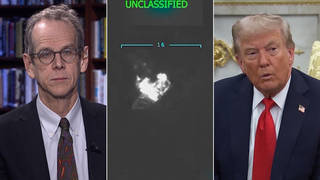

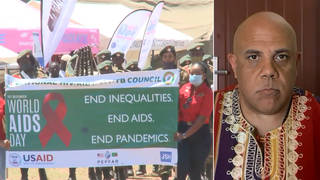
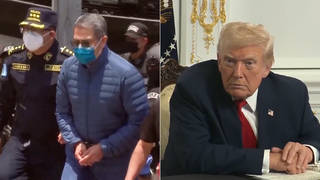





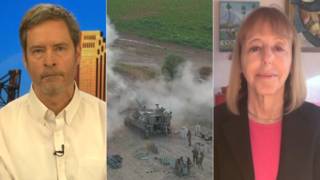
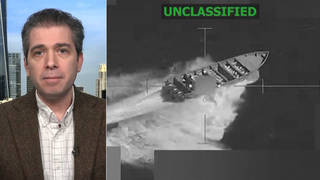
Media Options